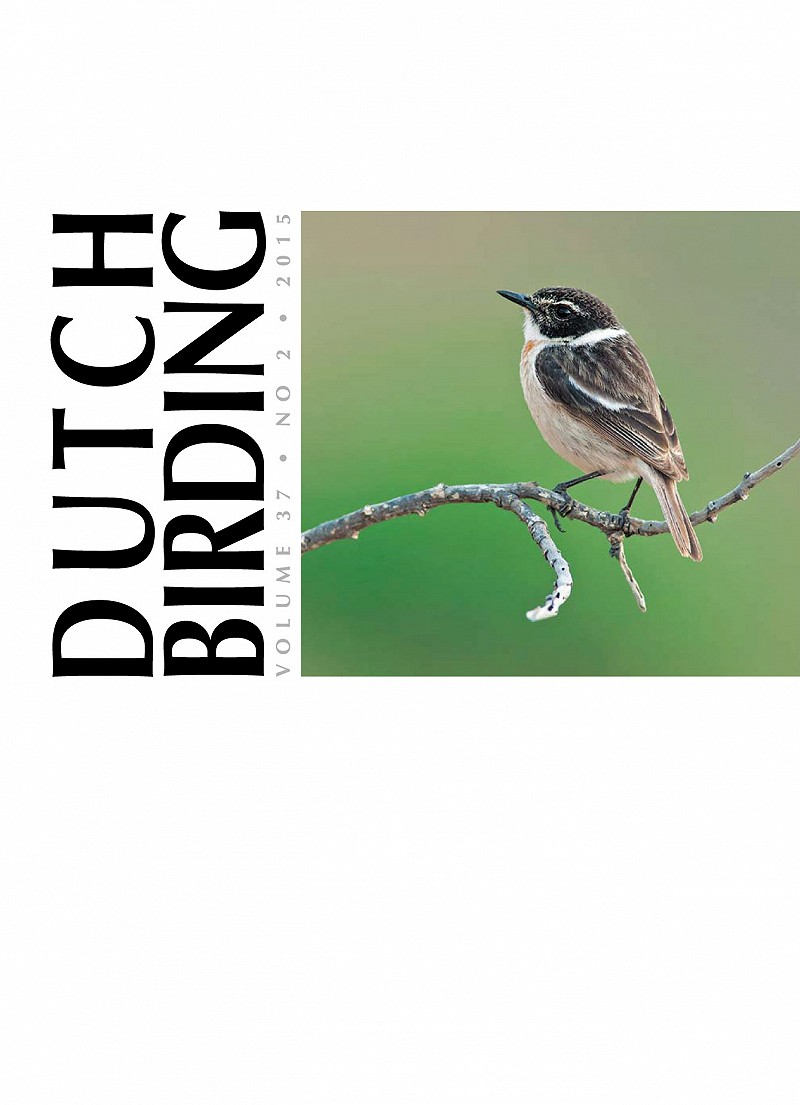Dutch Birding jaargang 37 nummer 2, 2015
VoorpaginaCanarische Roodborsttapuit · Saxicola dacotiaeRené Pop |
|
Artikelen / papers | |
| 69 - 79 |
Spaanse Mussen in Nederland in 1997-2014
Enno B Ebels, Gert-Jan Versteeg & Garry Bakker
The first Spanish Sparrow Passer hispaniolensis in the Netherlands was a male which stayed near De Cocksdorp on Texel, Noord-Holland, on 4-15 May 1997. The second concerned a male at Camperduin, Noord-Holland, on 13 May 2000. In 2009, an influx occurred with up to 10 individuals (maximum of four males and six females) at Eemshaven, Groningen, on 9-12 April, a male near Den Hoorn on Texel on 17-20 April and a male at Maasvlakte, Zuid-Holland, on 20-27 April (seen only on 20-21 and 26-27 April). On 6 May 2010, a female was identified and documented by photographs and sound-recordings at IJmuiden, Noord-Holland. The first autumn record concerned a male at Maasvlakte on 26-30 October 2014. All records are documented in this paper, with emphasis on the birds for which no paper had been published previously (ie, all three records in 2009 and the bird in 2014). For the 2009 and 2014 records, full descriptions are given and the identification and ageing are discussed. Elsewhere in north-western Europe, there are 15 records up to 2014 of which 10 in Britain. Other records are from Finland (one), north-western France (May 2007; excluding up to six birds in May 1995 presumed to have been ship-assisted), Norway (two) and Sweden (one). When it comes to individuals, the Netherlands account for 16 out of 31 birds recorded in north-western Europe.
Enno B Ebels, Joseph Haydnlaan 4, 3533 AE Utrecht, Nederland |
| 80 - 85 |
Russian-ringed Tundra Peregrine Falcon in Sardinia, Italy, in November 2011 and winter movements
Marcello Grussu & Riccardo Paddeu
20 november 2011 werd door een herder een gewonde Slechtvalk Falco peregrinus met een Russische ring (Moskwa CS006254) opgeraapt op Sardinië, Italië. De vogel had een gebroken vleugel en werd naar een asiel gebracht. Hij bleek op 3 augustus 2011 als nestjong te zijn geringd (nest met twee jongen) in het Nenetsky-natuurreservaat, Nenets, Siberië, Rusland (68°20'N, 53°14'O). Op grond van deze broedlocatie betrof het een Toendraslechtvalk F p calidus en de eerste terugmelding van een geringd exemplaar van deze ondersoort in Italië.
Recent zijn Toendraslechtvalken ook met satellietzenders uitgerust en resultaten voor drie exemplaren uit verschillende delen van Siberië zijn weergegeven in figuur 1. Hieronder bevindt zich ook een vrouwtje dat jaarlijks overwinterde in Portugal en in 2009-11 over het noorden van Italië trok tijdens zowel de najaars- als voorjaarstrek (met uitzondering van voorjaar 2011 toen de vogel ten noorden van Italië passeerde). De problemen rond herkenning van calidus worden kort besproken aan de hand van literatuur. Individuele vogels zijn waarschijnlijk niet of slechts in uitzonderlijke gevallen met zekerheid op ondersoort te determineren. Marcello Grussu, Gruppo Ornitologico Sardo, CP 160/C, 09045 Quartu Sant'Elena, Cagliari, Italy |
| 86 - 91 |
Fregetta storm petrels off Juan Fernández archipelago, Chile, in March 2013 and February 2015
Hadoram Shirihai, Hernán A Díaz & Vincent Bretagnolle |
| 92 - 94 |
Retained barred feathers in adult-summer Long-tailed Jaeger
Rob S A van Bemmelen |
| 95 - 97 |
Surveys of Chestnut-bellied Sandgrouse in Egypt in 2013-14
Mohamed I Habib |
| 98 - 101 |
Namaqua Doves breeding in southern Egypt in 2012-13
Jens Hering, Peter H Barthel & Elmar Fuchs |
| 102 - 104 |
Kleine Torenvalk op De Hoge Veluwe in maart 2002
Wim Wilmers, Enno B Ebels & Bram Rijksen
On 23 March 2002, a kestrel Falco was photographed at National Park De Hoge Veluwe, Gelderland, the Netherlands. The photographer posted his single photograph of the bird on www.birdpix.nl, labelled as Common Kestrel F tinnunculus. Some years later, doubts were raised about this identification because the bird clearly shows pale claws, a feature unique to Lesser Kestrel F naumanni. It took some more years before the file was complete (eg, the exact date of the observation) but, eventually, the report was submitted and, in 2014, accepted by the Dutch rarities committee (CDNA). In addition to the pale claws, features visible in the photograph pointing to Lesser are the less pronounced head pattern (due to less or narrower streaking) and the relatively narrow black bars on the feathers of mantle and shoulder. This was the second record for the Netherlands; the first concerned a first-year female found weakened (and dying shortly after) at Bergen, Noord-Holland, on 5 November 2000.
|
| 105 - 106 |
Ring Ouzel breeding in Northern Timan mountains, Russia, in June 2014
Dmitry Dorofeev |
| 107 - 108 |
Plain Leaf Warblers near Van Gölü, Turkey, in June 2004
Martin Gottschling, Stefan Pfützke & Felix Weiss |
Varia | |
| 109 - 115 |
Mascarene Petrels at sea off Réunion, Indian Ocean
Hadoram Shirihai, Tony Pym & Vincent Bretagnolle |
Trends in systematics | |
| 116 - 120 |
Olive Warbler: an Old World relict in the New World
Enno B Ebels |
CDNA-mededelingen | |
| 121 |
Recente CDNA-besluiten
CDNA |
WP reports | |
| 122 - 128 |
late January to late March 2015
Arnoud B van den Berg |
Recente meldingen / recent reports | |
| 129 - 138 |
Januari-februari 2015
Roy Slaterus, Vincent van der Spek & Martijn Renders |
DB actueel | |
| 139 - 140 |
Grijze Junco in Groningen [Dark-eyed Junco]
Jacob Bosma |

